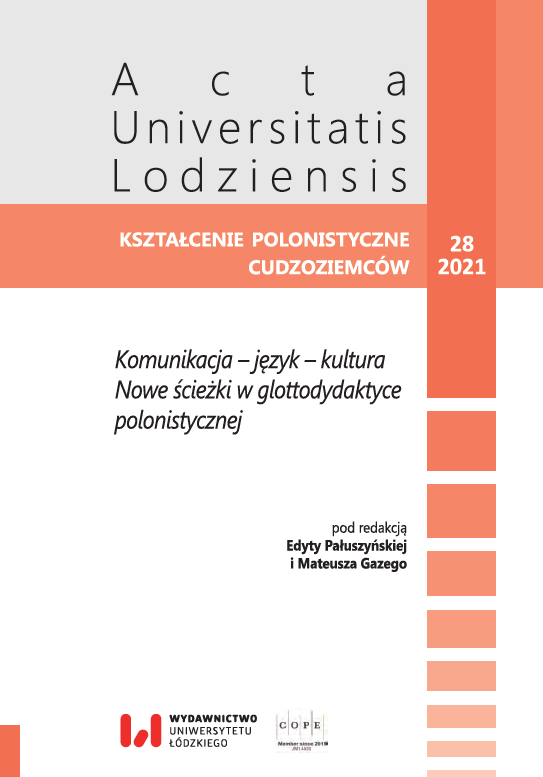The number of actual words and the average polish words in texts and the relation to the readability scale of jasnopis.pl. Comparative analysis and practical implications
DOI:
https://doi.org/10.18778/0860-6587.28.22Keywords:
Readability, text difficulty, average wordAbstract
The length of a text will be different depending on the choice of unit, if that should be the number of Actual Words (AW) or Average Words (APW, Moździerz 2020). The ratio of AW to APW in a text changes along with this text’s difficulty. An analysis of the ratio’s change across seven levels of readability on jasnopis.pl (publicly accessible program to asses the difficulty of Polish texts) scale was done. Ten thousand words from authentic Polish texts were collected for each level on jasnopis.pl, and their examination allowed the capture of the ratio’s change. As a result, a table of ratio proportional to different readability levels was created, which allows the easy assessment of any Polish text’s difficulty, by comparison of the text’s ratio to the table. Such an easily accessible assessment tool can be used in the process of Polish language education.
References
Alderson J., 2000, Assessing Reading, Cambridge.
Google Scholar
DOI: https://doi.org/10.1017/CBO9780511732935
Broda B., Ogrodniczuk M., Nitoń B., Gruszczyński W., 2014, Measuring Readibility of Brysbaert M., 2019, How many words do we read per minute? A review and meta-analysis of reading rate https://psyarxiv.com/xynwg/ (dostęp: 29.05.2020), DOI: 10.31234/osf.io/xynwg
Google Scholar
DOI: https://doi.org/10.31234/osf.io/xynwg
Carver R.P., 1972, Evidence for the invalidity of the Miller-Coleman Readability Scale, „Journal of Reading Behavior”, nr 4(3), s. 42–47.
Google Scholar
DOI: https://doi.org/10.1080/10862967109546999
Carver R.P., 1976, Word Length, Prose Difficulty and Reading Rate, „Journal of Reading Behavior”, nr 8(2) s. 193–204.
Google Scholar
DOI: https://doi.org/10.1080/10862967609547176
Carver R.P., 1977–78, Toward a Theory of Reading Comprehension and Rauding, „Reading Research Quarterly”, nr 13(1), s. 8–63.
Google Scholar
DOI: https://doi.org/10.2307/747588
Charzyńska E., 2015, Text topic interest, the willingness to read and the level of reading comprehension among adults — the role of gender and education level, „The New Educational Review”, vol. 39, nr 1, s. 84–95.
Google Scholar
DOI: https://doi.org/10.15804/tner.2015.39.1.07
Charzyńska E., Dębowski Ł., 2015, Empirical verification of the Polish formula of text difficulty, „Cognitive Studies”, nr 15, s. 125–132 https://doi.org/10.11649/cs.2015.010 (dostęp: 29.05.2020).
Google Scholar
DOI: https://doi.org/10.11649/cs.2015.010
Chen X., Meurers D., 2018, Word frequency and readability: Predicting the text-level readability with a lexical-level attribute, „Journal Research in Reading”, t. 41, nr 3, s. 486–510. DOI:10.1111/1467-9817.12121
Google Scholar
DOI: https://doi.org/10.1111/1467-9817.12121
Crossley S., Skalicky S., Dascalu M., 2019, Moving beyond classic readability formulas: new methods and new models, „Jorunal of Research in Reading”, t. 42, nr 3–4, s. 541–561. DOI:10.1111/1467-9817.12283
Google Scholar
DOI: https://doi.org/10.1111/1467-9817.12283
Dale E., Tyler R.W., 1934, A Study of the Factors Influencing the Difficulty of Reading Materials for Adults of Limited Reading Ability, „The Library Quarterly: Information, Community, Policy”, nr 4(3), s. 384–412.
Google Scholar
DOI: https://doi.org/10.1086/613490
Dębowski Ł., Nitoń B., Broda B., Charzyńska E., 2015, Jasnopis – A Program to Compute Readibility of Texts in Polish based on Psycholinguistic Research, w: B. Sharp, W. Lubaszewski, R. Delmonte (red.), Natural Language Processing and Cognitive Science, Proceedings 2015, Kraków, s. 51–61.
Google Scholar
DuBay W.H., 2004, The Principles of Readability https://www.researchgate.net/publication/228965813_The_Principles_of_Readability (dostęp: 15.09.2020).
Google Scholar
Ellis N. C., 2002, Frequency Effects in Language Processing: A Review with Implications for Theories of Implicit and Explicit Language Acquisition, „Studies in Second Language Acquisition”, nr 24(2), s. 143–188. https://doi.org/10.1017/S0272263102002024
Google Scholar
DOI: https://doi.org/10.1017/S0272263102002024
Grabe W., 2009, Reading in a Second Language, Cambridge.
Google Scholar
DOI: https://doi.org/10.1093/oxfordhb/9780195384253.013.0006
Gray W., Leary S., 1935, What makes a book readable, Chicago.
Google Scholar
Gruszczyński W. i in., 2015, Measuring Readability of Polish Texts, w: Z. Vetulani, J. Mariani (red.), Materiały Konferencji LTC 2015 (7th Language & Technology Conference: Human Language Technologies as a Challenge for Computer Science and Linguistics, Poznań, 27–29 listopada 2015), Poznań, s. 445–449.
Google Scholar
Lado, R., 1955, Patterns of Difficulty in Vocabulary, „Language Learning”, nr 6(1), s. 23–41 https://doi.org/10.1111/j.1467-1770.1955.tb00829.x
Google Scholar
DOI: https://doi.org/10.1111/j.1467-1770.1955.tb00829.x
Laufer B., 1990, Why Some Words are More Difficult Than Others, „IRAL”, nr 28(4), s. 293–307 https://doi.org/10.1515/iral.1990.28.4.293
Google Scholar
DOI: https://doi.org/10.1515/iral.1990.28.4.293
Na L., Nation, I.S.P. (1985). Factors Affecting Guessing Vocabulary in Context. “RELC Journal”, nr 16(1), s. 33–42 https://doi.org/10.1177/003368828501600103
Google Scholar
DOI: https://doi.org/10.1177/003368828501600103
Piekot T., Zarzeczny G., Moroń E., 2019, Standard „plain language” w polskiej sferze publicznej, w: M. Zaśko-Zielińska, K. Kredens (red.), Lingwistyka kryminalistyczna. Teoria i praktyka, Wrocław, s. 197–214.
Google Scholar
Pisarek, W., 1972. Frekwencja wyrazów w prasie: wiadomości, komentarze, reportaże, „Biblioteka wiedzy o prasie, seria B”, t. 16, Kraków.
Google Scholar
Polish Texts: Baseline Experiments, w: N. Calzolari i in. (red.). Materiały z konferencji LREC 2014 (9th International Conference on Language Resources and Evaluation, Rejkiawik, 26–31 maja 2014), Rejkiavik, s. 573–580.
Google Scholar
Reeves L.M., Hirsch-Pasek K., Golinkoff R., 2005, Słowa i znaczenia – od pojęć pierwotnych do złożonych struktur, w: J. Berko Gleason, N. B. Ratner (red.), Psycholingwistyka, Gdańsk, s. 173–240.
Google Scholar
Seretny A., 2006, Wskaźnik czytelności tekstu jako pomoc w określaniu stopnia jego trudności, „Ling-Varia”, nr 2(2), s. 87–98.
Google Scholar
Seretny A., 2011, Kompetencja leksykalna uczących się języka polskiego jako obcego w świetle badań ilościowych, Kraków.
Google Scholar
Seretny A., 2016, Stopień trudności słowa w perspektywie glottodydaktycznej, „Języki Obce w Szkole”, nr 60(1), s. 18–25.
Google Scholar
Sigurd B., Eeg-Olofsson M., van de Weijer J., 2004, Word Length, Sentence Length and Frequency – Zipf Revisited, „Studia Linguistica”, nr 58(1), s. 37–52.
Google Scholar
DOI: https://doi.org/10.1111/j.0039-3193.2004.00109.x
Sung Y.T. i in., 2015, Leveling L2 Texts Through Readability: Combining Multilevel Linguistic Features with the CEFR, „The Modern Language Journal”, t. 99, nr 2, s. 371–379.
Google Scholar
DOI: https://doi.org/10.1111/modl.12213
Wolter D., 2017, Moving readers from struggling to proficient, „The Phi Delta Kappan”, nr 99, s. 37–39.
Google Scholar
DOI: https://doi.org/10.1177/0031721717728277
Yeni-Koshian G., 2005, Percepcja mowy, w: J. Berko Gleason, N.B. Ratner (red.), Psycholingwistyka, Gdańsk, s. 121–173.
Google Scholar
Downloads
Published
How to Cite
Issue
Section
License

This work is licensed under a Creative Commons Attribution-NonCommercial-NoDerivatives 4.0 International License.










